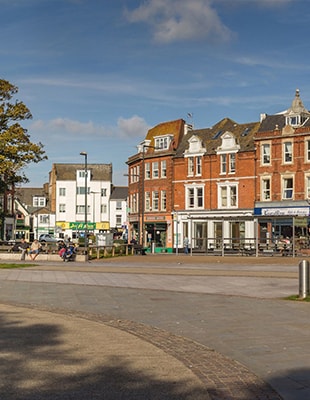The first generation of Build to Rent (BTR) projects in the UK have grown up and are now making their way in the world, providing a framework for growing communities and kick-starting urban regeneration nationwide.
During the early days of BTR, we borrowed theory and best practice from other countries to inform our design strategies. Enough time has now passed to reflect on the achievements of this pioneering cohort and to set a course for the next generation of BTR in an uncertain and fast-changing world.
One of the defining characteristics of BTR is the enhanced alignment of stakeholders behind a shared goal of creating long-term building performance and fostering strong communities. This is not typical in the broader construction sector and holds out the promise of a more collaborative way of working when business models are shifted to longer-term horizons.
At Arcadis, we are promoting a culture of collaboration and continual improvement by advocating for the benefits of Post Occupancy Evaluation and sharing our learnings with our clients and collaborators. Some of the key insights are:
- The theory works. Good BTR schemes are measurably better than the Buy to Let alternative, with high-quality shared space and amenities fostering community life being the tangible differentiator. BTR’s accelerated absorption rates make a compelling proposition to local communities, often initiating regeneration and renewal of neighbourhoods.
- It is important to carefully choreograph the arrival experience and engender a sense of community through the interaction of concierge, front door, post room, corridors, lifts and amenity areas, and to simultaneously consider this as an operational proposition: how do we make the operator’s life easier? Employ a pragmatic design approach that drives standardisation at all scales but not at the expense of character or a sense of place. Design for the full range of construction technologies, from traditional methods of construction right through to volumetric modular, to realise optimum construction and operational efficiencies irrespective of how the building is constructed.
- The first-generation customers, Millennials, are growing up, having kids, some are getting divorced and all are getting old. BTR is tasked with broadening its appeal and varying its offer to cater for a much more complex customer base with different household sizes, lifestyles and physical needs.
- Working from home has driven much greater daytime utilisation of shared amenity areas, which in turn calls for a greater variety of spaces, from private areas for video calls to dual-purpose dining/meeting rooms to large shared worktables with good lighting.
- Simple, relatively inexpensive and low-maintenance amenities such as tennis courts are just as popular as swimming pools and reinforce an active lifestyle and community connections.
We can distil these learnings and ally them to various societal trends to create a road map for the future of our sector, a broader, more varied and adaptive, full spectrum BTR.
The sector has delivered almost 100,000 residential units over the last 10 years and now constitutes approximately 2% of the private rented sector in the UK, with commentators predicting this proportion to grow to over 20% in the decades to come. As the sector scales, it will need to broaden its offer to accommodate a much bigger slice of the population, serving a wider range of incomes, age, household size and locations. This will drive increased product variety.
The background trends that will power this evolutionary process are:
- Our society is getting older. Over a quarter of the UK’s population is projected to be over 65 years old by 2066 – we need a broad-based, multi-tenure senior living sector including rental but not all of us want to live in retirement communities, rather a return to living in truly intergenerational communities feels inevitable. The space between healthcare and residential design will be a fertile ground for innovation to establish a new design standard for lifetime housing that responds to the needs of a much older population with more dynamic physical and neurological needs. At Arcadis, we are anticipating this trend with our Radius concept: modular adaptable apartments that can meet future health needs.
- Changing household composition – increasing single-person household formation. Birth rates are dropping but the need for housing will continue to outstrip population growth as traditional household arrangements break down and new living arrangements become established. This will require greater unit type variety within communities and product type variety across BTR, think senior co-living and suburban studios.
- Increasing the cohort of lifetime and mobile BTR customers with finite budgets and enhanced expectations who are not afraid to vote with their feet. People are becoming more mobile in their private and professional lives and BTR will react to this, replicating brand and service offers across multiple geographies, imagine if Soho House did BTR?
- Affordability pressures will be a market factor for the foreseeable future – salary increases are generally not keeping pace with living costs. This reality will drive greater product innovation to open up BTR to a larger slice of the population by making it more affordable by leveraging scale, increasing digital operations, and making amenities more modest and flexible, by going suburban or even rural.
- Increasing the digitalisation of everyday life. The threshold is blurring between physical and digital reality, what does this mean for BTR? Perhaps we will see a gamification of community life with blended reality multi-player experiences and reward systems for contributing to community life. Digital twins will be pervasive and deepen the relationship between residents and building management teams. Augmented reality will arguably allow much more flexible use of space.
- Increased awareness by residents of built environment factors affecting mental health and well-being. We need a deeper, more neuro-aware design approach – considering the implications of air, light, sound, nutrition, comfort, community, materials and mind. Imagine a future where the number one sales pitch for a BTR community is their superior air quality.
- Decarbonisation of the built environment. We need to radically rethink how we design, construct and use our buildings. To drive down the amount of embodied carbon in our buildings, we are challenged to significantly extend functional life by making buildings both more durable and flexible to accommodate change over many decades. Next-generation BTR schemes need to be sustainable and designed for the long term – beyond the usual 40–50-year lifespan, pushing lifespans well beyond a century, in fact, the way we used to build. A likely future scenario may be that buildings are expressed in distinct layers with a rugged durable frame of double and triple-height floors with large spans between columns, a flexible infill that is configured to create the building accommodation, all wrapped in a high-performance Passivhaus envelope. This creates a contemporary take on the long-lived warehouse buildings of the 18th and 19th centuries that are still with us and have had many incarnations over their life.
As the effects of climate change accelerate, we need to create much more resilient and adaptive buildings and communities. Dramatically reducing energy consumption and maximising the amount of on-site energy generation is an obvious and important priority which is well under way but we need to move faster. On-site food production will become a consideration, indeed our Arcadis colleagues in North America are integrating urban farming into their schemes, creating buildings that can become truly self-sufficient, which we see as an evolution of the allotment garden.
There is a significant opportunity for those players in the sector that get this right and for BTR in general to lead the decarbonisation of construction, revolutionise housing design and improve health and well-being amongst residents.
Originally published in Show House




